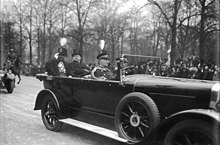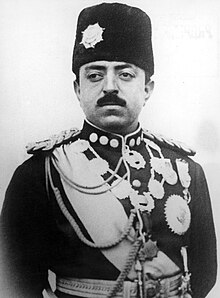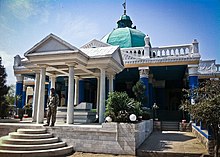Amanullah Khan


Amanullah Khan , also Aman Ullah ( Pashtun and Persian امان الله خان, DMG Amānu'llāh Ḫān ; * June 1, 1892 in Paghman , Afghanistan ; † April 25, 1960 in Zurich , Switzerland ) was emir from 1919 to 1926 , then king of Afghanistan from 1926 to 1929 .
Life
Amanullah Khan was the third son of Emir Habibullah Khan and Sarwar Sultanah. In 1919 he was able to prevail against the actual heir to the throne Nasrullah Khan and took over the throne from his murdered father. In the third Anglo-Afghan war that broke out shortly afterwards in May 1919, the Afghan army was initially able to achieve greater successes against the British with the support of Pashtun tribal warriors. In return, the British bombed Amanullah's palace. On August 8, 1919, in the Peace of Rawalpindi, Afghanistan was provisionally recognized as a sovereign and independent state by Great Britain.
Amanullah Khan launched a series of social and political modernization efforts. In 1926 he changed his title from Emir to Padschah (King). In opposition to the king's efforts to open up economically to the West, and particularly to Germany and the British Empire, there were numerous uprisings that weakened the king's power. A high point of these revolts occurred during the king's trip abroad in 1927 (also known as the " Khost Revolt "). Amanullah Khan skilfully navigated between Russian and British interests and was thus able to develop an independent national foreign policy. But his domestic political reforms were based on Kemal Ataturk's modernization project. So his wife Soraya took off the veil. Its initial popularity began to wane rapidly. The conservative rural population and the Pashtun tribes refused to modernize, which was felt to be hasty.
In January 1929 he was finally overthrown by Habibullah Kalakâni . He went via India to Italy (Rome), then in 1953 to Zurich / Switzerland into exile, where he died on April 25, 1960.
family
Married:
- 1st marriage: Schazaha Hanim
- 2nd marriage: Soraya Tarzi Hanim
- 3rd marriage: Aliah Begum
Children of Schazaha Hanim:
- Prince Shahdazajan Hedayatullah Khan
Children of Soraya Tarzi Hanim:
- Princess Dr. Meliha Begum †
- Princess Anima Begum
- Princess Abedah Begum
- Crown Prince Rahmatullah Khan
- Princess Adela Begum
- Prince Ehsanullah †
- Princess Hindya
- Princess Nadija Begum
He had no children with Aliah Begum.
Honors
- 1928: Order of the Golden Spur
- 1928: Order of the White Eagle
- 1928: Royal Victorian Chain
Trivia
During his visit to Berlin , the king was allowed to drive an AII subway car of the Berlin subway himself. Then the vehicles of this series were given the nickname "Amanullah-Wagen".
literature
- Christian Saehrendt : “Who should pay for that? The state visits of the kings Amanullah of Afghanistan, Faisal (Iraq) and Fuad (Egypt) to Berlin in the 1920s ”, in: Damals 7/2009.
- Jules Stewart: On Afghanistan's Plains. The Story of Britain's Afghan Wars . IB Tauris. London / New York 2011. ISBN 978-1-84885-717-9 .
- Aman Ullah , in: Internationales Biographisches Archiv 20/1960 from May 9, 1960, in the Munzinger archive ( beginning of article freely available)
Web links
- Biography at afghanan.net
- Amanullah Khan on old photos
- Afghanistan during the reign of Amanullah Khan - travel report by the engineer Wilhelm Rieck (with photos)
- Newspaper article about Amanullah Khan in the 20th century press kit of the ZBW - Leibniz Information Center for Economics .
Individual evidence
| personal data | |
|---|---|
| SURNAME | Khan, Amanullah |
| BRIEF DESCRIPTION | King of Afghanistan |
| DATE OF BIRTH | June 1, 1892 |
| PLACE OF BIRTH | Paghman , Afghanistan |
| DATE OF DEATH | April 25, 1960 |
| Place of death | Zurich , Switzerland |


